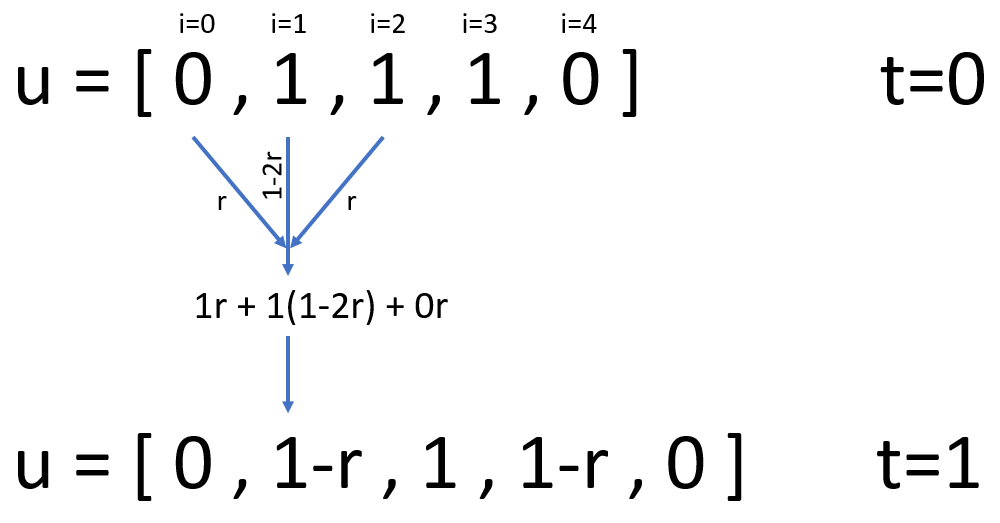Unit Testing Challenge
Overview
Teaching: 10 min
Exercises: 50 minQuestions
How do I apply unit tests to research code?
How can I use unit tests to improve my code?
Objectives
Use unit tests to fix some incorrectly-implemented scientific code
Refactor code to make it easier to test
Introduction to your challenge
You have inherited some buggy code from a previous member of your research group: it has a unit test but it is currently failing. Your job is to refactor the code and write some extra tests in order to identify the problem, fix the code and make it more robust.
The code solves the heat equation, also known as the “Hello World” of Scientific Computing. It models transient heat conduction in a metal rod i.e. it describes the temperature at a distance from one end of the rod at a given time, according to some initial and boundary temperatures and the thermal diffusivity of the material:

The function heat() in diffusion.py attempts to implement a step-wise
numerical approximation via a finite difference
method:
This relates the temperature u at a specific location i and time point t
to the temperature at the previous time point and neighbouring locations. r is
defined as follows, where α is the thermal diffusivity:
We approach this problem by representing u as a Python list. Elements within
the list correspond to positions along the rod, i=0 is the first element,
i=1 is the second and so on. In order to increment t we update u in a
loop. Each iteration, according to the finite difference equation above, we
calculate values for the new elements of u.

The test_heat() function in test_diffusion.py compares this approximation
with the exact (analytical) solution for the boundary conditions (i.e. the
temperature of the end being fixed at zero). The test is correct but failing -
indicating that there is a bug in the code.
Testing (and fixing!) the code (50 min)
Work by yourself or with a partner on these test-driven development tasks. Don’t hesitate to ask a demonstrator if you get stuck!
Separation of concerns
First we’ll refactor the code, increasing its modularity. We’ll extract the code that performs a single time step into a new function that can be verified in isolation via a new unit test:
In
diffusion.pymove the logic that updatesuwithin the loop in theheat()function to a new top-level function:def step(u, dx, dt, alpha): …Hint: the loop in
heat()should now look like this:for _ in range(nt - 1): u = step(u, dx, dt, alpha)- Run the existing test to ensure that it executes without any Python errors. It should still fail.
Add a test for our new
step()function:def test_step(): assert step(…) == …It should call
step()with suitable values foru(the temperatures at timet),dx,dtandalpha. It shouldassertthat the resulting temperatures (i.e. at timet+1) match those suggested by the equation above. Useapproxif necessary. _Hint:step([0, 1, 1, 0], 0.04, 0.02, 0.01)is a suitable invocation. These values will giver=0.125. It will return a list of the form[0, ?, ?, 0]. You’ll need to calculate the missing values manually using the equation in order to compare the expected and actual values.- Assuming that this test fails, fix it by changing the code in the
step()function to match the equation - correcting the original bug. Once you’ve done this all the tests should pass.Solution 1
Your test should look something like this:
# test_diffusion.py def test_step(): assert step([0, 1, 1, 0], 0.04, 0.02, 0.01) == [0, 0.875, 0.875, 0]Your final (fixed!)
step()function should look like this. The original error was a result of some over-zealous copy-and-pasting.# diffusion.py def step(u, dx, dt, alpha): r = alpha * dt / dx ** 2 return ( u[:1] + [ r * u[i + 1] + (1 - 2 * r) * u[i] + r * u[i - 1] for i in range(1, len(u) - 1) ] + u[-1:] )
Now we’ll add some further tests to ensure the code is more suitable for publication.
Testing for exceptions
We want the
step()function to raise an Exception when the following stability condition isn’t met:Add a new test
test_step_unstable, similar totest_stepbut that invokesstepwith analphaequal to0.1and expects anExceptionto be raised. Check that this test fails before making it pass by modifyingdiffusion.pyto raise anExceptionappropriately.Solution 2
# test_diffusion.py def test_step_unstable(): with pytest.raises(Exception): step([0, 1, 1, 0], 0.04, 0.02, 0.1) # diffusion.py def step(u, dx, dt, alpha): r = alpha * dt / dx ** 2 if r > 0.5: raise Exception …
Adding parametrisation
Parametrise
test_heat()to ensure the approximation is valid for some other combinations ofLandtmax(ensuring that the stability condition remains true).Solution 3
# test_diffusion.py @pytest.mark.parametrize("L,tmax", [(1, 0.5), (2, 0.5), (1, 1)]) def test_heat(L, tmax): nt = 10 nx = 20 alpha = 0.01 …After completing these two steps check the coverage of your tests via the Test Output panel - it should be 100%.
The full, final versions of diffusion.py and test_diffusion.py are available on GitHub.
Bonus tasks
- Write a doctest-compatible docstring for
step()orheat()- Write at least one test for our currently untested
linspace()function
- Hint: you may find inspiration in numpy’s test cases, but bear in mind that its version of linspace is more capable than ours.
Key Points
Writing unit tests can reveal issues with code that otherwise appears to run correctly
Adding unit tests can improve software structure: isolating logical distinct code for testing often involves untangling complex structures
pytest can be used to add simple tests for python code but also be leveraged for more complex uses like parametrising tests and adding tests to docstrings